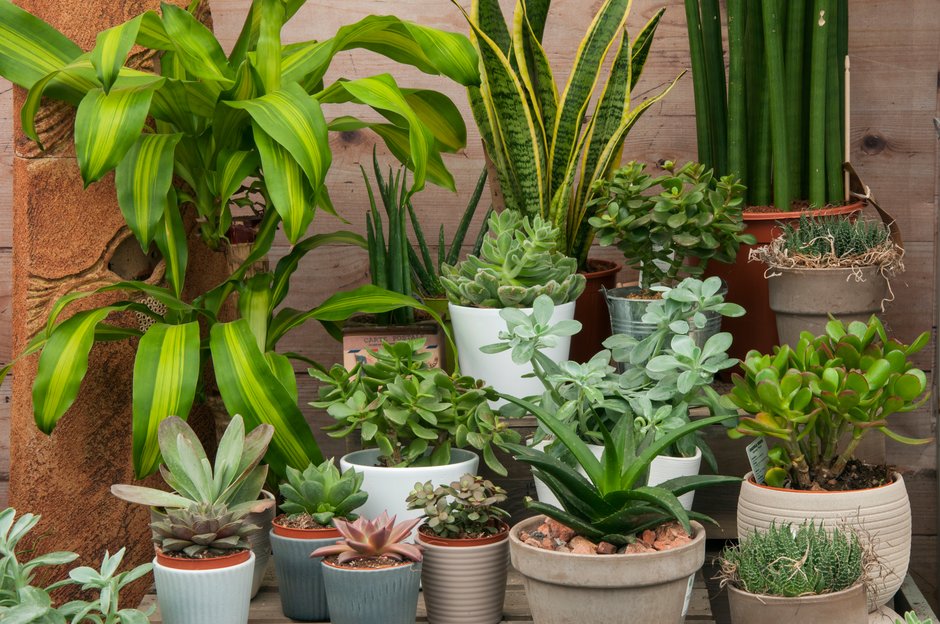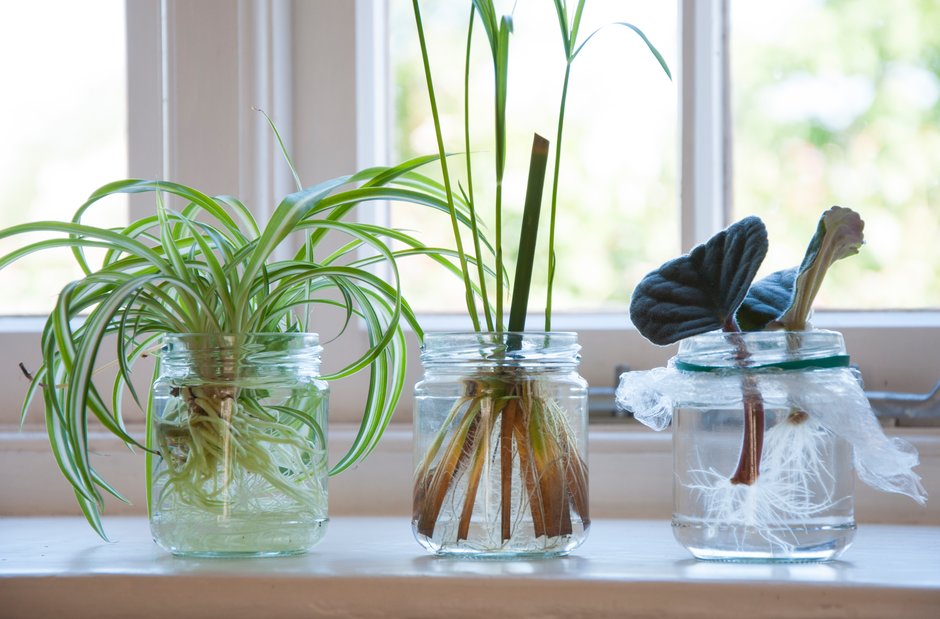We’re a nation that loves to fill our homes with houseplants. Beyond adding a splash of green, they can improve air quality, boost wellbeing, and bring a calming atmosphere to any space.
But, keeping houseplants thriving isn’t always straightforward. Even the most well-intentioned plant parents can find themselves puzzled when their green friends start looking a bit worse for wear.
So we’ve teamed up with the RHS to offer some guidance for home growers. Whether you’re a complete beginner or someone who’s struggled to keep plants alive in the past, understanding the most common mistakes can help you keep your plants happy.
Or, take a look at some of these growers’ mistakes to watch out for…
1. Overwatering and underwatering
Over or underwatering are probably the most common mistakes plant owners make, and it can be surprisingly tricky to get right. The key is understanding that different plants have different water needs, and that these needs change throughout the year.
Overwatering is often more harmful than underwatering. When plants sit in soggy soil, their roots can’t breathe properly and may start to rot. Signs include yellowing leaves that drop off, mouldy patches on leaves, dark mushy roots, and sometimes a musty smell coming from the soil.
Underwatering, on the other hand, causes plants to wilt, develop brown crispy edges on leaves, and flowers that fade quickly. The older leaves at the base of an underwatered plant typically yellow and fall first.
The best way to check if your plant needs water is to stick your finger about 2cm into the soil. If it feels dry, it’s time to water. When you do water, give the plant a thorough drink until water drains from the bottom, then empty any standing water from the bottom of your plant pot after about 30 minutes.
2. Getting the light levels wrong
Light is like food for plants, but getting the balance right can be challenging. Too little light leads to weak, spindly growth, pale leaves, poor flowering and lower leaves turning yellow and dropping off. You might also notice that some plants lose their distinctive markings and revert to plain green.
Too much direct sunlight, particularly through glass windows, can be just as problematic. Strong summer sun can cause brown scorched patches on leaves, giving them a washed-out appearance. This is especially common on shade-loving plants and the paler sections of variegated leaves.
Most houseplants prefer bright, indirect light. This means they can see the sky from their position but aren’t sitting directly in a beam of sunlight. South-facing windows can be too intense in summer but perfect in winter when the sun is weaker. North-facing windows often don’t provide enough light, especially during the darker months.
3. Temperatures that stress your plants
Plants are surprisingly sensitive to temperature changes, and our homes can present some challenging conditions. Heat stress from sitting too close to radiators or in very hot conservatories can cause leaves to wilt, roll up or become crispy. Rooms that get very hot in summer sun can also cause problems.
Cold damage is equally harmful. Unheated porches, conservatories or rooms that get very cold overnight can cause leaves to turn black, droop or even lead to complete plant collapse. Draughts from doors, windows and air conditioning can shock plants and cause similar problems.
Most houseplants prefer steady temperatures between 18-24°C during the day, with a slight drop at night. Avoid placing plants near heat sources like radiators or in draughty hallways where temperatures fluctuate dramatically.
4. Humidity levels that leave plants gasping
This is particularly problematic during winter when central heating dries out the air. Low humidity causes brown, crispy leaf tips and edges, shrivelled leaves and early dropping of leaves, buds and flowers. Many tropical houseplants, which make up the majority of our indoor plants, naturally come from humid jungle environments.
Conversely, too much humidity can cause grey mould on leaves and flowers, particularly in bathrooms that don’t have good ventilation.
You can increase humidity around your plants by grouping them together, placing them on trays of damp pebbles, or misting them regularly. Bathrooms with good natural light often make excellent homes for humidity-loving plants.
5. Nutrient deficiencies that stunt growth
Plants living in pots eventually use up all the nutrients in their compost, which can lead to lacklustre growth, poor flowering and yellowing leaves with green veins. This is particularly common with plants that have been in the same pot for years without feeding or repotting.
During the growing season (March to October), most houseplants benefit from monthly feeding with a liquid fertiliser. In winter, when growth slows due to lower light levels, reduce feeding to once a month or stop altogether.
Different plants have different nutritional needs. Foliage plants generally prefer fertilisers higher in nitrogen, while flowering plants need more phosphorus and potassium. Plants that prefer acidic conditions, like azaleas, need special ericaceous fertiliser.
6. Choosing plants that don’t suit the space
This mistake often happens when we fall in love with a plant’s appearance without considering whether our home can provide what it needs. A sun-loving succulent won’t thrive in a dim bathroom, and a humidity-loving fern will struggle in a dry living room.
Before buying any plant, research its specific needs for light, temperature, humidity and space. Consider how big it will grow and whether you can provide the right conditions year-round. It’s much better to choose plants that will naturally thrive in your conditions than to struggle with ones that are unsuited to your space.
Top tips to keep your houseplants thriving

Now that you know what to avoid, let’s look at some practical strategies to help you sidestep these common mistakes, to make sure your houseplants thrive.
Going on holiday, without killing your plants
One of the biggest worries for plant owners is what happens when they go away. The good news is that most houseplants can cope with a few days without attention, but longer holidays need some planning.
For short trips in summer, move plants away from bright windows to reduce water loss and give them a thorough watering before you leave. In winter, plants can often manage a week or two as long as the temperature stays stable.
For longer absences, try the wick method: place one end of a strip of capillary matting in a large container of water and tuck the other end into your plant pot. The plant will draw water as needed. Alternatively, group smaller plants on a tray of wet capillary matting with one end trailing into a water source.
You can also cover individual plants with clear plastic bags to create a mini greenhouse effect, but only for short periods, as this can lead to fungal problems.
Choosing the right plants for children
If you’ve young children at home, plant safety will be high on your list. Many plants are perfectly safe, and plant care can actually be beneficial for children’s development – with a great sense of achievement watching something grow.
Safe options include spider plants (Chlorophytum), snake plants (Sansevieria), prayer plants (Maranta) and various peperomias. These are not only non-toxic, but also relatively forgiving if little hands get a bit too enthusiastic with the watering can.
Avoid plants like dieffenbachia (dumb cane), certain euphorbias and oleander, which can be harmful if eaten. If you have very young children, consider placing plants on high shelves until they’re older.
Using plants to boost your wellbeing
Research shows that caring for houseplants, and having them around our homes, can have remarkable effects on our mental health and wellbeing. A recent study found that certain plant characteristics are particularly beneficial for psychological health.
Plants with soft, rounded shapes and lush green foliage are considered most uplifting and relaxing. Top performers include weeping figs (particularly when pruned into sphere or column shapes), pothos with its trailing vines, and palms, which might evoke memories of holidays, or tropical destinations.
The key is choosing healthy plants with dense, bright green foliage. Unhealthy plants actually have the opposite effect, making people feel worse rather than better. This reinforces the importance of proper plant care.
Learning to take cuttings

One of the most rewarding aspects of houseplant care is learning to propagate your own plants. Taking cuttings is easier than you might think and provides an endless supply of plants to expand your collection or give as gifts.
Choose healthy stems about 8-10cm long and make a clean cut just below a leaf joint. Remove the lower leaves, leaving just 2-3 at the top. You can either place the cutting in a glass of water (keeping the water level just below the leaves) or plant it directly into a 50:50 mix of multipurpose compost and perlite.
Some of the easiest plants to propagate include pothos, spider plants (which produce ready-made babies), rubber plants and most succulents. Spring and early summer are the best times for taking cuttings when plants are actively growing.
Keep cuttings in a warm, bright spot but out of direct sun. Most will develop roots within 3-4 weeks. Once rooted, water-grown cuttings can be potted up into small pots with fresh compost.
By understanding the common mistakes and implementing these helpful strategies, you’ll be well on your way to creating a thriving indoor garden that brings joy and benefits to your home for years to come.
The RHS website features tips and advice on how to handle houseplants, and RHS members can access its personalised advice service.
For more guidance on going greener at home, take a look at our energy efficiency guides.
Photo credit: Jason Ingram for the RHS.
Copyright © 2000-2026 Rightmove Group Limited. All rights reserved. Rightmove prohibits the scraping of its content. You can find further details here.